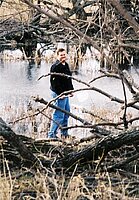Using GIS and Digital Terrain Data to Model Groundwater Interaction in Prairie Wetlands

Chris Laveau has B.S. in Environmental Geology and Technology and is a graduate of the Honors Program at the University of North Dakota, Grand Forks. Presently pursuing a M.S. in Geology at UND with a research emphasis in the area of hydrogeology. Funding from the Water Resource Research Institute is being used to support thesis work on modeling the spatial and temporal distribution of prairie wetlands. Career experience includes a student appointment to the Water Resource Division of the United States Geological Survey in Grand Forks.
Fellow: Christopher Laveau, Department of Geology and Geological Engineering, UND
Advisor: Phil Gerla, Professor of Geology and Geological Engineering, UND
Matching Support: ND EPSCoR, NSF Biocomplexity Research Cluster at UNDNSF Diversity in the Geosciences INGEOS (Indians into the Geological Sciences) grant
Degree Progress: M.S. expected in December 2004.
Using GIS and Digital Terrain Data to Model Groundwater Interaction in Prairie Wetlands
Prairie potholes are water-holding depressions of glacial origin in the northern portion of the Great Plains. They are significant hydrologic features because of the role they play in flood control, water supply, and biological activity of prairie communities. This role is often a function of the existing water balance within the wetland.
Hydrologic investigations (e.g. Shjeflo, 1968; Woo and Roswell, 1992) found that direct precipitation and spring runoff from snowmelt were the major sources of water supply for prairie potholes, while evapotranspiration was the major cause of water loss. Their results indicated that northern prairie potholes have a negative water balance with respect to the atmosphere.
With more water leaving than entering from the atmosphere the persistence of a prairie pothole in the landscape is directly related to its groundwater budget (Sloan, 1972). An understanding of groundwater dynamics has important applications in predicting the spatial and temporal distribution of wetlands. The thesis is focused on working with spatial datasets and groundwater modeling (Gerla, 1999) to explain the distribution and persistence of wetlands within the upper Turtle River drainage basin in Grand Forks and Nelson counties, North Dakota.
Chris Laveau is working on a model to describe, quantitatively, the spatial and temporal distribution of prairie potholes in the upper Turtle River watershed. Gerla (1999) used a method of integrating digital terrain data with groundwater modeling to estimate the local configuration of the water table. The estimation technique combines the use of digital elevation models (DEMs) with numerical modeling to solve the groundwater equation for transient, unconfined flow. The thesis is taking the next steps with this initial research. The model has been redesigned to incorporate the heterogeneity of hydraulic conductivity. The model output on groundwater conditions is being quantitatively compared to field data using a statistical program. The current goal is to incorporate the statistical program into the groundwater model. The result will be a groundwater model with input parameters derived from readily available spatial datasets and output that is immediately and quantitatively compared to field data.
Presentations:
University of North Dakota RNEST Biocomplexity Workshop (2003) -Speaker
4th Biennial ND/SD Joint EPSCoR Conference (2003)

Phil Gerla
Geology & Geological
Office: Leonard Hall Room 2013
81 Cornell Street Stop 8358
Grand Forks, ND 58202-8358
Telephone: 701-777-3305
Email: philip.gerla@UND.edu


